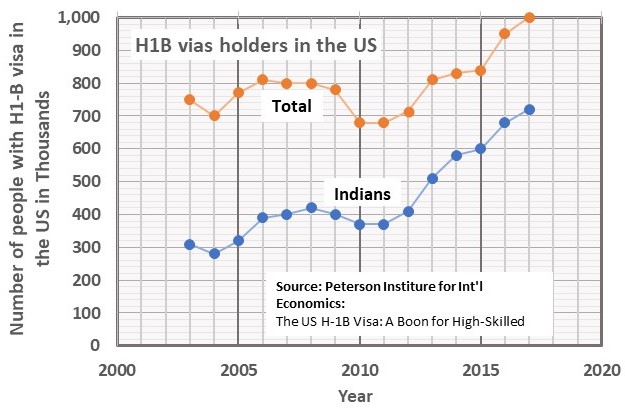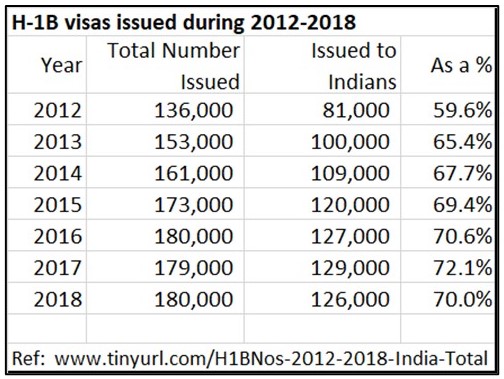The IT sector in the US saw explosive growth in the last two decades. Flagship IT companies — Amazon, Google, Microsoft, Meta, and others — employed Indian “techies” in large numbers, most on the H-1B visa. A look at the H-1B visa numbers summarized in the tables and plots in this article reveals how extensively Indians have flooded the IT jobs all across the US.
Simultaneously, people in the know have been warning that the IT sector globally is ready for a major correction and upgrade through Artificial Intelligence (AI). The self-learning AI, they said, will eliminate repetitive low-skill jobs across all sectors, including in IT, the jobs that can be done by software and computer-aided machines. In addition, in the history of the US economy, boom-bust cycles have been a common theme.
So, if we put all these together, as you will see below, the on-going large-scale layoffs in the IT sector was something that was waiting to happen. And when it did indeed happen starting from July 2022, it was inevitable that Indians were the most affected. One is tempted to say, Indians were walking — worse still, sleep-walking — into this maelstrom.
The IT industry described itself using fancy adjectives to embellish its attributes — pathbreaking, revolutionizing, life-altering, 21-st century phenom, futuristic, mind blowing, dizzying… Soon a lifestyle evolved around this phenom: casual dress, company-paid fancy food platters, laundromats and gyms at workplaces. Even 3-week paid vacation days was not unheard of. Workplaces and office parks became campuses.
With IT jobs aplenty and not enough employees to hire from within the US, companies went on a hiring spree bringing workers from overseas, even raiding other companies, for employees. A 2018 story in the Seattle Times reported that foreign-born IT workers in the Seattle area accounted 40% of the total of 143,000 employees. In the San Jose area in California, over 70% of IT workers are foreign-born.
In India, IT workers have been enjoying ever increasing salaries and benefits, with weekend haunts to Goa, Malaysia, Sri Lanka, Thailand, Mauritius becoming the norm.
To meet this demand, universities started offering majors and minors in Data Analytics, Managing Information Technology, e-Commerce, Web Applications, Data Mining… They organized events bringing together graduating IT students and hiring managers/venture capitalists for link ups. IT students with exotic ideas and venture capitalists flush with cash were hovering around each other, as in mixer dancing, to create the next trailblazing startup.
With startups and new IPOs and their acquisition by the industry Big Boys, these were heady days, and the ambience dizzy for the 20-somethings!! Even through the Covid pandemic, the IT sector saw a boom because of the growth of e-commerce. With people working from home, business in home-office furniture and gadgets saw a spurt while sales in undergarments saw a decline.
For ambitious students — and their parents — in India, their career choices were cutout for them: degrees and trade certificates in computer-related fields, followed by a 3-semester master’s program in India — better still, in US universities — that would lead to prized IT jobs. Graduating students walked into Google, Microsoft, FaceBook, Amazon and other lesser-known companies in the US with exotic names, all on the temporary H-1B visas. They wanted jobs in the Bay Area, Seattle, LA, or New York City, Boston. Austin, Atlanta, the DC area… … Jobs in Little Rock, Ark or Birmingham, Ala were punishments.
Alarmed at the American IT industry’s appetite for hiring people from overseas (which also helped the industry to keep salaries low), the federal government capped the number of IT-related overseas hires at 65,000 per year for people with bachelor’s degrees, and 20,000 per year for people with US-earned master’s degrees under the H-1B visa regime. Indians started flooding this employment market, gobbling up around 75% of the 85,000 H-1B visas for 2020 and 2021. A look at the plots and tables on these pages tells how Indians have been overwhelming the H-1B visa system — and how Indians eventually got trapped into H-1B net.
With Indians applying for the H-1B visas in numbers far, far exceeding the allotted cap, the US consular offices in India resorted to a lottery system to pick applicants for H-1B visas. In this milieu, everybody was taking advantage of everybody else, and not everything was kosher or Shudh, or halal both from the employers’ and the employees’s end.
As experts predicted, starting in late 2022, American IT companies have used the post-Pandemic global recession and laid off over 200,000 tech employees so far. Not many of these jobs will come back because these companies have been readying themselves to launch AI platforms for many routine IT tasks. It was therefore inevitable, and also entirely predictable that Indians on H-1B visas are the largest number laid off.
The Big Picture to contextualize the problem: Even though the IT industry is critical to the American economy, as Forbes magazine (December 18, 2022), reported, the tech sector is a small part of the US workforce, accounting for only 2% of the 150 million workers.
Besides, the recent layoffs of tens of thousands of IT employees from the Big Boys in the industry — FaceBook, IBM, Google, Microsoft, Cisco, among others — are between 5 to 10 percent of their workforce, small in relative terms.
Also, while the tech sector layoffs are getting wide media coverage here (and wider coverage in the Indian media), the overall unemployment rate in the US is still as low as it has ever been in the last several decades. Many sectors are having difficulty in recruiting workers.
Indian IT companies such as TCS, Infosys, Wipro too laid off employees since they heavily depend on their US and EU clients. With Indian IT campuses located in urban hubs in India, their IT employees coming from the anglicized urban middle class, the Indian media were quick to highlight the woes of the laid off Indians both in the US and in India.
Vulnerable middle managers: In this milieu, middle level managers became vulnerable targets for layoffs because of the flattening of the organizational pyramid and replacement by youngsters at much lower salaries. Younger workers became formidable competitors since the management saw them as one way to reduce their operating costs.
Most Indians come to the US on the H-1B visa with the idea of becoming permanent residents here. But a major roadblock for Indians to becoming permanent residents has been the long waiting time, simply because so many of them are on the line for their green cards. Because of the large numbers of applicants from countries like India, the Philippines, China, and Mexico, they have to wait up to 15 years, or even longer.
Many Indians in the US on H-1B visa for 10 to15 years are in their mid to late 30s, living their American dream — with their homes in the suburbs with mortgage commitments, SUVs and annual vacations. Many have teenage school-going children. For these people, getting laid off midstream in life is a nightmare. They have only sixty days to get another job in an environment when tens of thousands of laid-off IT workers are looking for jobs, failing which they have to leave the US. These people are overwhelmed with a host of problems needing quick decisions, with the deportation sword hanging over their head. Piyush Seth and Lisa Ventresca, Pittsburgh-based immigration attorneys, are familiar with challenges these people face.
In recent years, many young Indians came to the US to pursue 3-semester courses in IT-related subjects in universities. They got IT jobs in the US upon graduation. Now, when these Indians on H-1B visas in their late 20s are laid off, their decision to return to India may appear less complicated because they are single or married with only young pre-school children. But their problems are of a different kind: many of these men and women in India took personal education loans for over $70,000 (around INR 6,000,000), and others,0 were funded by their parents. These loans are relatively easy to clear if their earnings are in US dollars, but a huge burden to repay if their earnings are in Indian rupees. With the Indian job market itself flooded with recently laid off local IT workers, if these people on the H-1B visa return to India, getting commensurately high-paying jobs in the Indian IT sector will be hard.
This recent IT layoffs in the US (and in India) have landed many Indians on the H-1B visa in a complex situation with social, cultural, financial, professional, and career- and family-related challenges, all hitting them at the same time, without any easy solution. But this was inevitable since Indians overwhelmed the H-1B visa regime.
However, Seth, the immigration attorney with 25 years experience, citing a Computer World article in February 2023, says, “Regardless of the layoffs in big companies, qualified IT jobs are still in demand with over 100,000 jobs remaining unfilled throughout the technology sector.” ∎









